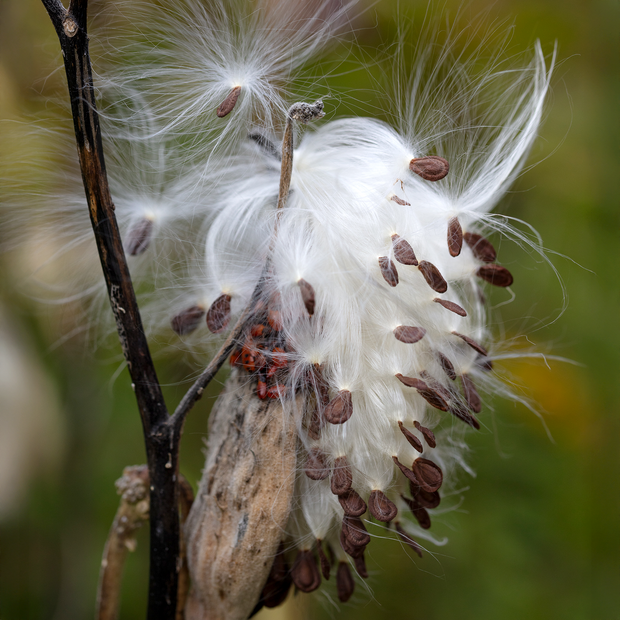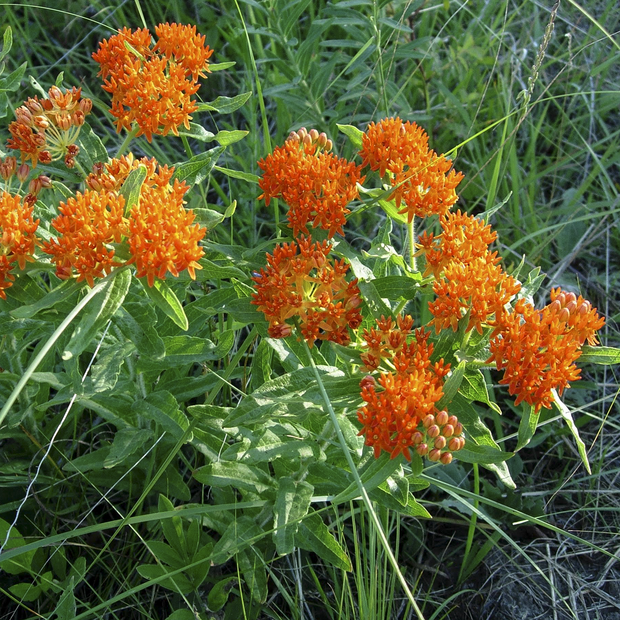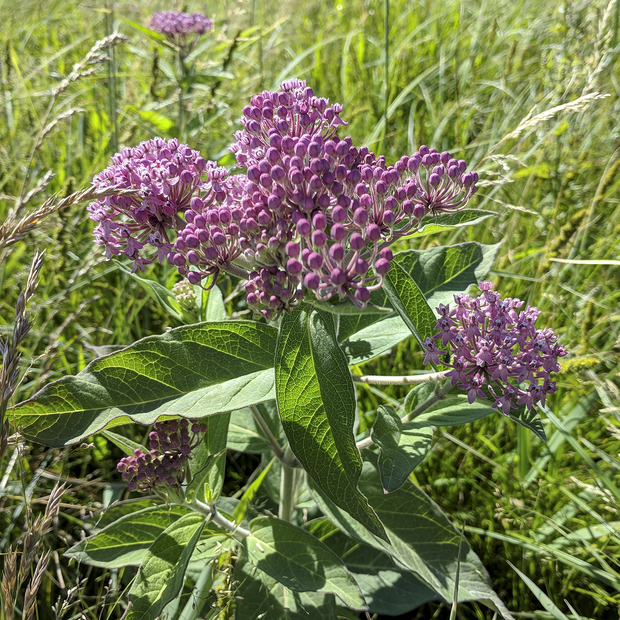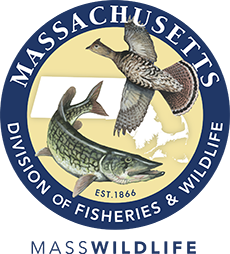- Division of Fisheries and Wildlife
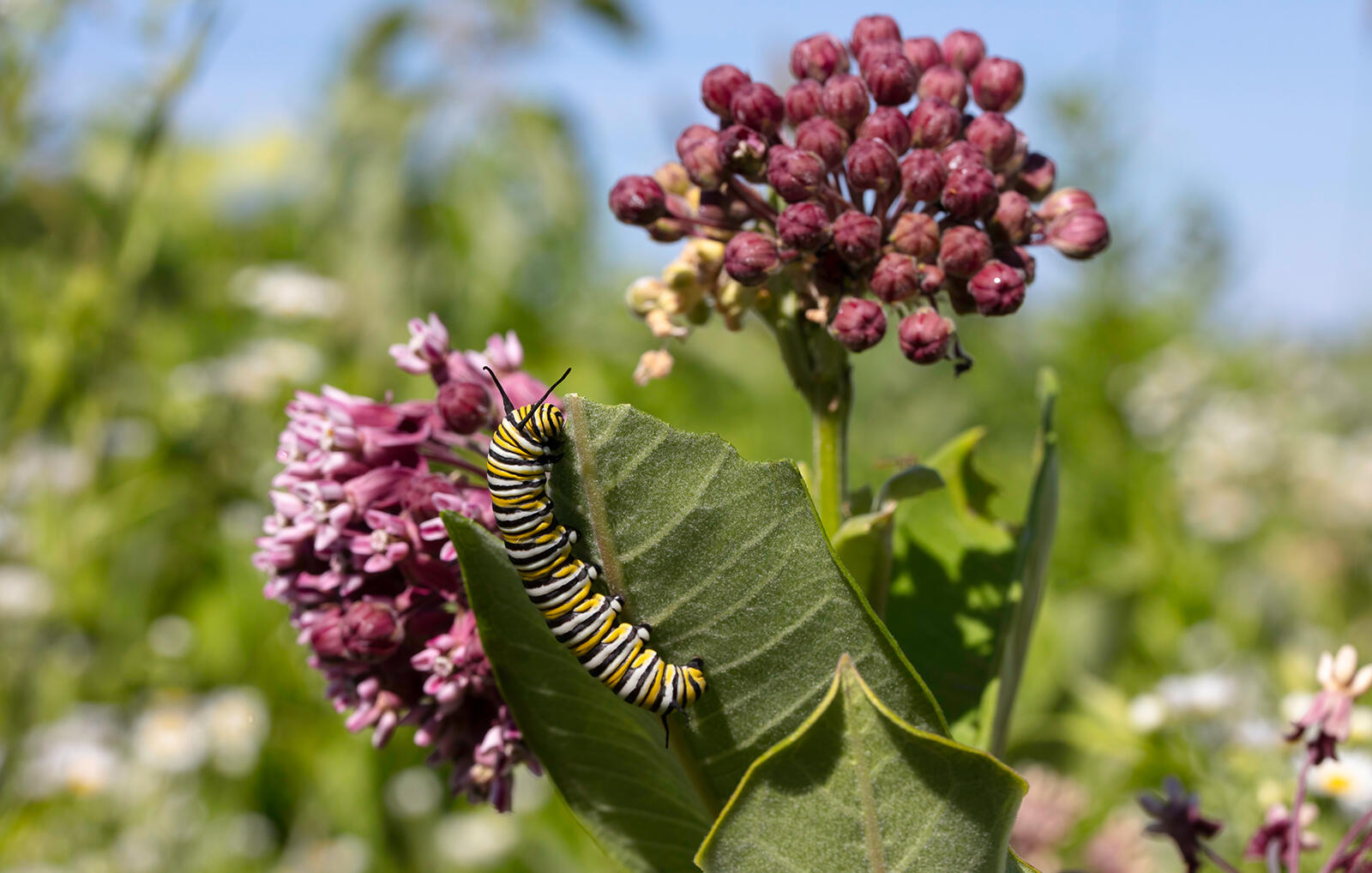
As their name suggests, many milkweed species produce a milky-white substance that can be seen if their stem is broken. Milkweed flowers are often fragrant and produce nectar for a wide array of butterflies, bees, and other pollinators. Caterpillars of the iconic monarch butterfly (pictured above) feed exclusively on milkweed leaves and cannot complete their lifecycle without these plants.
Many of us had our first encounter with milkweed as children, popping open a milkweed pod and plucking out the white fluff then releasing the feathery strands and attached seeds into the wind. Those seeds must land in a patch of bare soil for a new milkweed plant to take root. Areas like this, along with open habitats preferred by many milkweeds, are becoming scarce, making some of our eight native milkweed species rare. Habitat management projects, including prescribed fire, that restore open habitats can help reverse this trend.
Delve into the fascinating story of milkweeds by reading "Marvelous Milkweeds", an article written by MassWildlife Botanist Robert Wernerehl, published in Massachusetts Wildlife magazine. Learn how the milkweed's unique flower shape evolved to aid pollination and find out how milkweed fluff was collected right here in Massachusetts to help the US Navy during WWII!
Scroll down to get to know the eight milkweed species native to Massachusetts:
Common milkweed
Description: Stout, upright stems with broad oval leaves grow to 3–5 feet; clusters of flowers that range from pink to white. (See flower in top photo, seed pod in right photo.)
Habitat: Grasslands, open woodlands, floodplains, disturbed areas.
Common milkweed (Asclepias syriaca) is native to all 14 counties in Massachusetts. It’s the plant most often thought of when you hear the word “milkweed.” Common milkweed spreads through underground stems (rhizomes) that branch out from the main plant. Once established, common milkweed does not need to reseed often. Common milkweed produces nectar both night and day, providing food for moths at night and butterflies during the day.
Monarch caterpillars feast on the leaves of common milkweed and adult monarchs feed on nectar given off by the flowers. The leaves of all milkweed species are toxic to most insects, but monarchs have evolved the ability to isolate the toxic chemicals in specialized internal structures. This allows the monarch to avoid harm from the chemicals and serves as a defense against predators. Birds have evolved to recognize and avoid fowl-tasting, toxic monarch caterpillars.
Butterfly weed
Description: Typically grows in clumps of upright stems reaching 1–3 feet tall; flowers range from orange to yellow.
Habitat: Grasslands, open woodlands, pine barrens.
The brilliant orange flowers of butterfly weed (Asclepias tuberosa) light up meadows on Martha’s Vineyard, Nantucket, and areas of Cape Cod. This species has a wide range in North America, found in prairies in Texas and Oklahoma, all the way to Florida and northern Minnesota, as well as in New England.
At one time, butterfly weed was found throughout Massachusetts, but almost all populations have disappeared. Like most milkweeds, butterfly weed prefers open habitats and their seeds need to land on bare soil to germinate and grow. Some milkweeds flourished in the far more open landscape of the early-to-mid-19th century, when Massachusetts forests were almost entirely cleared for farming and other uses and fire was relatively widespread. Currently, Massachusetts is about 70 percent forested, which limits butterfly weed. Today, butterfly weed can flourish after controlled burns or wildfire.
Swamp milkweed
Description: Grows about 4 feet tall with attractive clusters of pinkish-purple flowers; leaves are long and narrow, tapering to a point.
Habitat: Moist grasslands and ditches, edges of ponds, streams, wetlands.
Swamp milkweed (Asclepias incarnata) is found in all New England states and is the only milkweed species to thrive in wetlands. There are two distinct varieties; one with a stem covered in short, white hairs (A. incarnata var. pulchra) and the other (A. incarnata var. incarnata) has no hairs. Readily available in the native plant nursery trade, swamp milkweed attracts many pollinators and is a great choice for planting in rain gardens.
Less common types of milkweed
- Four-leaved milkweed (Asclepias quadrifolia)
Description: Reaches about 2 feet tall with a delicate spray of off-white flowers. As its name suggests, the plant has 2-4 leaves attached to the stem at the same location (node).
Habitat: Prefers open oak woodlands and deciduous forests with light to moderate shade. Although it can be found throughout Massachusetts, it’s not common.
- Poke milkweed (Asclepias exaltata)
Description: Grows to about 4 feet tall with cream-colored flowers arranged in starburst clusters.
Habitat: Open oak woodlands on fertile soil, especially with a history of fire.
- Clasping-leaved milkweed (Asclepias amplexicaulis)
Description: It grows to 2–3 feet tall with drab green leaves that “clasp” the stem and features uniquely wavy leaf edges.
Habitat: Full sun, sandy soils. Found mainly on Cape Cod, the Islands, and parts of Plymouth County. Historically, it was found statewide when Massachusetts had more open habitats.
- Whorled milkweed (Asclepias verticillate)
Description: Grows to about 12 inches, with very narrow leaves and a small spray of white flowers.
Habitat: Dry soils with full sun.
Status: Listed as threatened under the Massachusetts Endangered Species Act. Loss of open habitats, fire suppression, and deer browse pressure have greatly diminished the range of this species.
- Purple milkweed (Asclepias purpurascens)
Description: Reached 4 feet in height, with deep reddish-purple clusters of flowers.
Habitat: Dry soils in open areas.
Status: Listed as endangered under the Massachusetts Endangered Species Act. Threats include loss of open habitats, development, and deer over browse.
